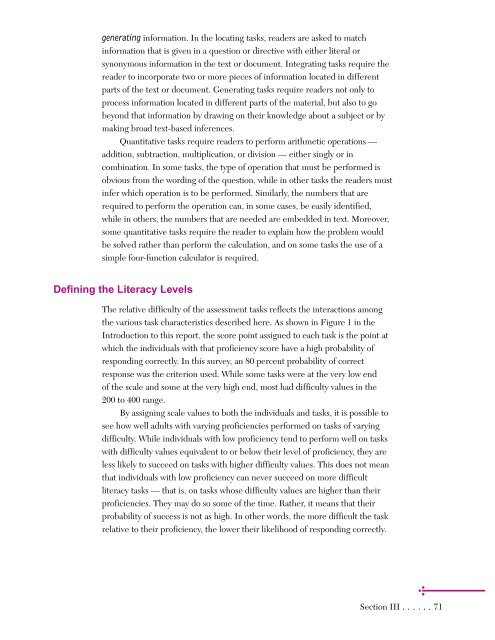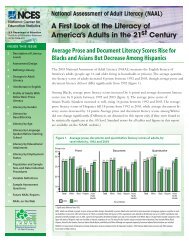Adult Literacy in America - National Center for Education Statistics ...
Adult Literacy in America - National Center for Education Statistics ...
Adult Literacy in America - National Center for Education Statistics ...
You also want an ePaper? Increase the reach of your titles
YUMPU automatically turns print PDFs into web optimized ePapers that Google loves.
generat<strong>in</strong>g <strong>in</strong><strong>for</strong>mation. In the locat<strong>in</strong>g tasks, readers are asked to match<br />
<strong>in</strong><strong>for</strong>mation that is given <strong>in</strong> a question or directive with either literal or<br />
synonymous <strong>in</strong><strong>for</strong>mation <strong>in</strong> the text or document. Integrat<strong>in</strong>g tasks require the<br />
reader to <strong>in</strong>corporate two or more pieces of <strong>in</strong><strong>for</strong>mation located <strong>in</strong> different<br />
parts of the text or document. Generat<strong>in</strong>g tasks require readers not only to<br />
process <strong>in</strong><strong>for</strong>mation located <strong>in</strong> different parts of the material, but also to go<br />
beyond that <strong>in</strong><strong>for</strong>mation by draw<strong>in</strong>g on their knowledge about a subject or by<br />
mak<strong>in</strong>g broad text-based <strong>in</strong>ferences.<br />
Quantitative tasks require readers to per<strong>for</strong>m arithmetic operations —<br />
addition, subtraction, multiplication, or division — either s<strong>in</strong>gly or <strong>in</strong><br />
comb<strong>in</strong>ation. In some tasks, the type of operation that must be per<strong>for</strong>med is<br />
obvious from the word<strong>in</strong>g of the question, while <strong>in</strong> other tasks the readers must<br />
<strong>in</strong>fer which operation is to be per<strong>for</strong>med. Similarly, the numbers that are<br />
required to per<strong>for</strong>m the operation can, <strong>in</strong> some cases, be easily identified,<br />
while <strong>in</strong> others, the numbers that are needed are embedded <strong>in</strong> text. Moreover,<br />
some quantitative tasks require the reader to expla<strong>in</strong> how the problem would<br />
be solved rather than per<strong>for</strong>m the calculation, and on some tasks the use of a<br />
simple four-function calculator is required.<br />
Def<strong>in</strong><strong>in</strong>g the <strong>Literacy</strong> Levels<br />
The relative difficulty of the assessment tasks reflects the <strong>in</strong>teractions among<br />
the various task characteristics described here. As shown <strong>in</strong> Figure 1 <strong>in</strong> the<br />
Introduction to this report, the score po<strong>in</strong>t assigned to each task is the po<strong>in</strong>t at<br />
which the <strong>in</strong>dividuals with that proficiency score have a high probability of<br />
respond<strong>in</strong>g correctly. In this survey, an 80 percent probability of correct<br />
response was the criterion used. While some tasks were at the very low end<br />
of the scale and some at the very high end, most had difficulty values <strong>in</strong> the<br />
200 to 400 range.<br />
By assign<strong>in</strong>g scale values to both the <strong>in</strong>dividuals and tasks, it is possible to<br />
see how well adults with vary<strong>in</strong>g proficiencies per<strong>for</strong>med on tasks of vary<strong>in</strong>g<br />
difficulty. While <strong>in</strong>dividuals with low proficiency tend to per<strong>for</strong>m well on tasks<br />
with difficulty values equivalent to or below their level of proficiency, they are<br />
less likely to succeed on tasks with higher difficulty values. This does not mean<br />
that <strong>in</strong>dividuals with low proficiency can never succeed on more difficult<br />
literacy tasks — that is, on tasks whose difficulty values are higher than their<br />
proficiencies. They may do so some of the time. Rather, it means that their<br />
probability of success is not as high. In other words, the more difficult the task<br />
relative to their proficiency, the lower their likelihood of respond<strong>in</strong>g correctly.<br />
Section III ......71



